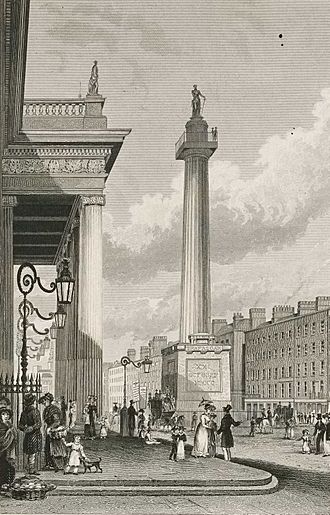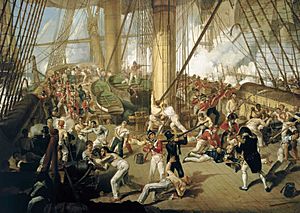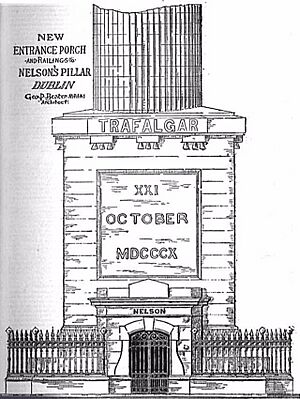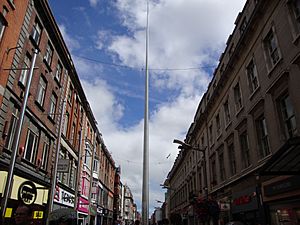Nelson's Pillar facts for kids
Quick facts for kids Nelson's Pillar |
|
|---|---|

Nelson's Pillar, c. 1830
|
|
| Alternative names |
|
| General information | |
| Status | Destroyed |
| Location | O'Connell Street Dublin, Ireland |
| Coordinates | 53°20′59.3″N 06°15′36.9″W / 53.349806°N 6.260250°W |
| Groundbreaking | 15 February 1808 |
| Opening | 21 October 1809 |
| Destroyed | 8 and 14 March 1966 |
| Client | Dublin Corporation |
| Design and construction | |
| Architect | |
Nelson's Pillar was a tall stone column in the middle of Dublin, Ireland. It had a statue of Horatio Nelson, a famous British admiral, on top. The Pillar was built in 1809 when Ireland was part of the United Kingdom.
People in Dublin decided to build the monument after Nelson's big victory at the Battle of Trafalgar in 1805. The original design was changed to save money. The statue was made by Thomas Kirk.
From the start, the Pillar was a popular place for tourists to visit. But some people didn't like it because it honored an Englishman in the heart of Dublin. As Irish people wanted more independence, many wished for the Pillar to be taken down.
The Pillar stayed in Dublin even after Ireland became independent in 1922. Laws made it hard to remove. Famous writers like W. B. Yeats wanted to keep it for its history. But many still wanted it gone, especially before the 50th anniversary of the Easter Rising in 1966.
In March 1966, explosives badly damaged the Pillar. What was left of it was later removed by the Irish Army. Years later, in 2003, a new tall structure called the Spire of Dublin was built in the same spot.
Contents
Building the Pillar
Why a Monument to Nelson?
On October 21, 1805, a British navy fleet, led by Vice Admiral Lord Nelson, won a big battle against the French and Spanish navies. This was the Battle of Trafalgar. Nelson was badly hurt during the battle and died that day, but his fleet won.
News of Nelson's victory reached Dublin in November. People were very happy and wanted to remember him. Many sailors in Nelson's fleet were from Ireland, including about 400 from Dublin. Business people were especially thankful because the victory made the seas safe for trade again.
On November 18, 1805, Dublin city leaders decided to build a statue to honor Nelson. A "Nelson committee" was formed to plan the monument and raise money.
Choosing the Design and Location
The committee asked artists and architects to send in ideas for the monument. Many designs for monuments at that time were like old Roman columns. The committee chose a design by a young English architect named William Wilkins. He suggested a tall column with a statue on top.
The committee decided to put the Pillar on Sackville Street (now O'Connell Street). This street had been improved in the 1700s and was a main road in Dublin. Some people worried about traffic, but the street was chosen anyway.
Raising enough money was difficult. Wilkins's design was too expensive. So, Francis Johnston, an architect for the city, changed the design to make it cheaper. He made the base simpler and replaced Wilkins's idea for a boat with a statue of Nelson. Thomas Kirk was hired to sculpt the statue.
Construction Begins
Even though they didn't have all the money yet, the committee felt ready to start building in 1808. The first stone was laid on February 15, 1808, with a big ceremony. Important city leaders and the Duke of Richmond, who was in charge of Ireland, were there.
The committee kept raising money as the Pillar was built. When it was finished in the autumn of 1809, it had cost about £6,856. But they had raised even more, so they had some money left over.
The monument, with its statue, stood 134 feet (40.8 m) tall. The base of the Pillar had the names and dates of Nelson's biggest victories carved into it. Inside the column, there was a spiral staircase with 168 steps. Visitors could climb to a viewing platform just below the statue. From there, they could see a great view of Dublin. The Pillar opened to the public on October 21, 1809, four years after the Battle of Trafalgar.
Life of the Pillar: 1809–1966
Early Years and Opinions
The Pillar quickly became a popular place for tourists. People said climbing it was a "must" for visitors to Dublin. But right from the start, some people didn't like it. Some felt it was a symbol of British rule.
In 1818, a history book about Dublin said the Pillar was "ponderous" (too heavy) and "clumsy." However, others thought the statue looked like Nelson and that the Pillar made the wide street look better.
By 1830, Irish people wanted more control over their own country. The Pillar was seen as a symbol of British power. Still, many visitors liked it. In 1842, writer William Makepeace Thackeray described Nelson "upon a stone-pillar" in the middle of Sackville Street. Some Dubliners were proud of it, calling it "Dublin's Glory" when Queen Victoria visited in 1849.
Calls for Removal
In 1853, a city plan suggested removing the Pillar. But this was difficult because a special group of trustees was legally bound to keep the monument forever. To move or change the Pillar, a special law had to be passed in London, not Dublin. So, the Pillar stayed.
Over the years, there were many attempts to remove it. In 1876, a former Lord Mayor suggested replacing it with a memorial to Sir John Gray, who helped bring clean water to Dublin. But the city government couldn't do it.
In 1882, a law was passed that would allow Dublin to move the Pillar, but the city couldn't act fast enough, and the law expired. A similar attempt in 1891 also failed. Not everyone wanted it gone. Some businesses thought the Pillar was important for the city, and the tram company wanted it to stay as a central stop. The Pillar had become a familiar part of Dublin.
In 1894, some changes were made to the Pillar. A new entrance was built on the south side with a grand porch, and heavy iron railings were put around the monument.
In the early 1900s, even though many Dublin city leaders were Irish nationalists, the Pillar was decorated with flags for Nelson's 100th anniversary in 1905. Other monuments celebrating Irish heroes were also built on Sackville Street, showing a changing political mood.
The Easter Rising of 1916
On April 24, 1916, during the Easter Rising, Irish rebels took over important buildings in central Dublin. One of these was the General Post Office (GPO) on Sackville Street, very close to the Pillar.
Sackville Street became a battlefield. Some stories say rebels tried to blow up the Pillar, but many who fought in the Rising said this wasn't true. They found the Pillar's large base useful for cover. British artillery fire set much of Sackville Street on fire, but the Pillar remained standing. One report said Nelson "surveyed it all serenely, as though he were lit up by a thousand lamps."
When the fighting ended, many buildings on Sackville Street were destroyed or badly damaged. The GPO was just a shell. But the Pillar had only minor damage, mostly bullet marks. One shot was even said to have taken off Nelson's nose!
In Independent Ireland
After Ireland became independent in 1922, Dublin became the capital of the Irish Free State. The Pillar was now an issue for the Irish government. In 1923, some people called for its removal, saying it was a "blunder."
The poet William Butler Yeats, who was in the Irish Senate, thought the Pillar should be moved, not destroyed. He believed it was part of Ireland's history. Sackville Street was renamed O'Connell Street in 1924.
Calls to remove or replace the Pillar continued for decades. The main problem was still the legal trust that protected it. Irish governments didn't want to pass new laws to override this trust. In 1936, a nationalist magazine said that keeping the Pillar showed a lack of national spirit.
By 1949, Ireland was the Republic of Ireland. Still, not everyone wanted the Pillar gone. Some historians and art experts thought it was a "grand work" and that O'Connell Street would lose its character without it. They also said it helped with traffic flow.
In 1955, a group of students from University College Dublin locked themselves inside the Pillar. They hung a poster of Kevin Barry, an Irish rebel, from the top. Police eventually broke in and ended the protest.
In 1956, some politicians suggested replacing Nelson's statue with one of Robert Emmet, an Irish rebel leader. They hoped this might encourage Protestants in Northern Ireland to support a united Ireland. There was even talk of moving the Pillar to Belfast, but this didn't happen.
In 1959, the government decided not to remove the Pillar because it was too expensive. Five years later, the leader, Seán Lemass, agreed to consider replacing Nelson's statue with one of Patrick Pearse, a leader of the Easter Rising, for its 50th anniversary in 1966. But as the anniversary came closer, Nelson's statue was still there.
The Pillar's End
On March 8, 1966, a powerful explosion destroyed the top part of the Pillar. Nelson's statue crashed to the ground. Luckily, O'Connell Street was almost empty, so no one was hurt, though a taxi driver nearby had a narrow escape. The Pillar was left as a jagged stump, about 70 feet (21 m) high.
The Irish government called the explosion "an outrage." Some people were sad to see a famous landmark gone. But many others were happy. Songs were written about the event, including the popular "Up Went Nelson." People joked, "Nelson has lost his last battle!" The Irish president, Éamon de Valera, even suggested a newspaper headline: "British Admiral Leaves Dublin By Air."
Dublin city officials declared the remaining stump a "dangerous building." The trustees agreed it should be removed. On March 14, the Irish Army used a controlled explosion to destroy the rest of the Pillar. A crowd watched and cheered. People rushed to grab pieces of the stone as souvenirs.
Some parts of the Pillar, including Nelson's head, are now in museums. Other pieces of the carved stonework are used as decoration in gardens.
What Happened Next?
Who Was Responsible?
At first, many thought the IRA was responsible for the explosion. But an IRA spokesperson denied it, saying they were not interested in destroying symbols. There were rumors that a Spanish group might have been involved.
In 2000, a former IRA member named Liam Sutcliffe said in a radio interview that he had planted the bomb. He said he had placed a bomb on February 28, but it didn't go off. He then returned on March 7 and placed a new bomb with a fixed timer. He said he slept through the night and only learned of the success the next day. Police questioned him but did not charge him.
What Replaced the Pillar?
For over twenty years, the spot where the Pillar stood was empty. Many ideas were suggested for a new monument. Some wanted a statue of Arthur Griffith, who founded Sinn Féin, or Patrick Pearse. But none of these ideas were chosen.
In 1988, a fountain called the Smurfit Millennium Fountain was put up near the site. It had a bronze statue of a woman. Some people didn't like it, calling it an "atrocious eyesore."
In 1997, Dublin city officials held a competition for a new monument to mark the year 2000. The winning design was the Spire of Dublin, a tall, needle-like structure that rises 120 metres (390 ft) into the sky. It was finished on January 22, 2003. During the digging for the Spire, the original foundation stone of Nelson's Pillar was found.
Images for kids
See also
 In Spanish: Columna de Nelson (Dublín) para niños
In Spanish: Columna de Nelson (Dublín) para niños








